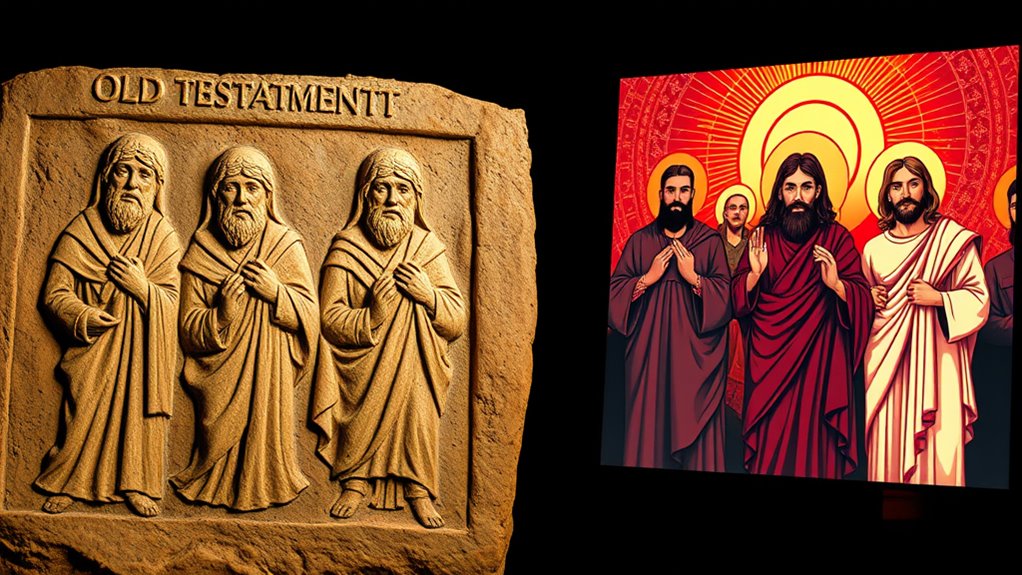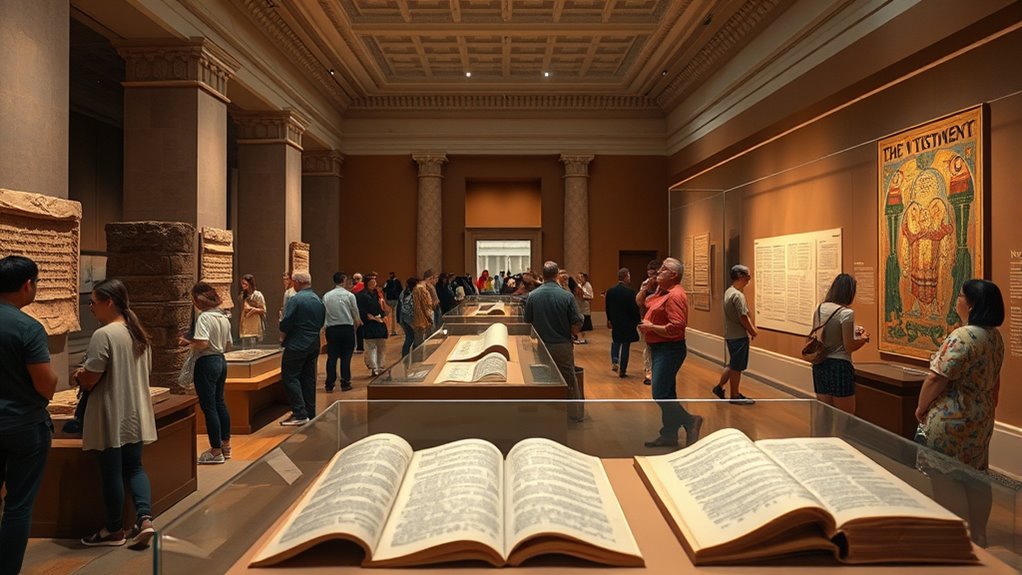The Old Testament focuses on God’s covenant, laws, and His relationship with Israel, using poetic and symbolic language to tell stories of faith and obedience. The New Testament centers on Jesus Christ, emphasizing love, salvation, and grace through clear storytelling and parables. While both reveal God’s plan, the Old Testament highlights divine promises and laws, and the New Testament shows their fulfillment in Jesus. Understanding their differences helps uncover deeper spiritual insights—you’ll find these distinctions become clearer as you explore further.
Key Takeaways
- The Old Testament focuses on God’s covenant, laws, and history, while the New Testament centers on Jesus’ life, teachings, and salvation.
- Old Testament employs poetic, symbolic language and narratives; the New Testament uses straightforward storytelling and parables.
- The Old Testament was written over centuries, emphasizing justice and divine promises; the New Testament was composed in the first century CE, highlighting grace and redemption.
- Key figures include prophets like Isaiah and Moses in the Old Testament, and Jesus, Peter, and Paul in the New Testament.
- The Old Testament emphasizes external obedience and moral laws; the New Testament emphasizes internal faith, love, and spiritual renewal.
The Composition and Structure of Each Testament

The composition and structure of the Old and New Testaments differ markedly, shaping how their messages are organized and understood. The Old Testament primarily follows a narrative structure, featuring stories, laws, and poetry that build on themes over time. It uses literary devices like parallelism and symbolism to deepen meaning and evoke emotion. In contrast, the New Testament centers around the life and teachings of Jesus Christ, often presenting material as sermons, letters, and parables that emphasize faith and salvation. Its structure is more focused and thematic, guiding you through the story of redemption. Recognizing these differences helps you appreciate how each covenant employs unique literary devices and narrative techniques to communicate profound spiritual truths effectively. Additionally, the water-related themes found in both testaments highlight the symbolic importance of water in spiritual renewal and cleansing. Exploring the literary devices used in each testament reveals how language shapes spiritual understanding and engagement. Furthermore, understanding the prophetic dreams and their interpretation can enrich your comprehension of biblical narratives and their divine messages. Appreciating the symbolism of water in scripture further enhances the depth of spiritual lessons conveyed through these texts. Moreover, the Hopi Tribe’s cultural practices demonstrate how natural elements like water influence spiritual symbolism and community rituals, paralleling biblical themes.
The Historical Context and Timeline

Understanding the historical context and timeline of the Old and New Scriptures reveals how their messages were shaped by the events and cultures of their times. The Old Testament was written over centuries, with many ancient manuscripts dating back to around 1000 BCE, reflecting the history and beliefs of ancient Israel. Archaeological findings, such as the Dead Sea Scrolls, have helped verify and date these texts. The New Testament, composed in the first century CE, captures events following the life of Jesus Christ, with earliest manuscripts from the 2nd century. These archaeological discoveries provide insight into the early Christian communities and help establish a timeline for their writings. Recognizing this context helps you understand how external influences and historical developments influenced the scriptures’ testament and messages. Additionally, the use of manuscript dating techniques has been crucial in confirming the age of these texts and understanding their historical placement. Historical analysis of these documents continues to shed light on how their content was shaped by the cultures and events of the respective eras. Furthermore, advancements in textual criticism have enhanced our understanding of how these scriptures were transmitted and preserved over time. Studying the cultural influences present during the periods of writing also provides deeper insights into the interpretations and variations found in ancient texts. The ongoing discovery of ancient manuscripts continues to refine our understanding of the development of biblical texts over centuries.
Primary Themes and Messages

Exploring the primary themes and messages of the Old and New Scriptures reveals how their teachings reflect the beliefs and values of their respective cultures. The Old Testament origins emphasize themes like covenant, obedience, justice, and God’s unwavering faithfulness to His people. It highlights God’s justice, mercy, and the importance of following laws. In contrast, the New Testament symbolism centers on love, redemption, grace, and the promise of eternal life through Jesus Christ. Its messages focus on forgiveness and spiritual renewal. You’ll find that the Old Testament sets the foundation with laws and history, while the New Testament offers hope through symbolism of sacrifice and resurrection. These themes shape the core messages, illustrating the evolving relationship between humanity and the divine. Additionally, scriptural context plays a significant role in understanding how these themes develop within their respective texts. Recognizing the cultural influences that shaped each testament can deepen our comprehension of their distinct messages and purposes. Moreover, understanding the literary styles used in each testament can enhance our appreciation of their unique communication methods. Furthermore, an awareness of historical background can provide valuable insights into the development of these themes over time. Studying tableware can also offer a window into the cultural practices that influenced these texts, revealing how social and ceremonial elements are woven into religious narratives.
The Focus on Covenants and Laws

Have you ever wondered how the Old and New Scriptures differ in their emphasis on laws and promises? In the Old Testament, Covenantal Laws and Moral Codes are central, shaping the relationship between God and His people. These laws, like the Ten Commandments, set clear standards for behavior and highlight God’s covenant with Israel. They serve as a foundation for moral living and societal order. The New Testament, however, shifts focus from strict adherence to laws toward principles of love, grace, and internal transformation. While moral codes remain important, they are now fulfilled through faith and the guidance of the Holy Spirit. This shift emphasizes a personal relationship with God, moving from external compliance to internal devotion. Additionally, the concept of covenants underscores the evolving nature of God’s promises and commitments to humanity, reflecting a deeper understanding of divine commitments beyond mere legal obligations. This transition also signifies a move from external obedience to internal spiritual renewal, highlighting the importance of inner faith over mere ritual compliance. The focus on moral standards highlights how divine guidance has adapted to meet the spiritual needs of believers.
Key Figures and Their Roles

You’ll see how key prophets and leaders shape the story of salvation, guiding people and delivering God’s messages. These central figures hold essential roles that influence both the Old and New Testaments. Understanding their significance helps you grasp how they contribute to God’s plan for humanity. For example, the power of prophecy played a crucial role in conveying divine messages and guiding the faithful throughout biblical history. Recognizing the different roles of biblical figures enhances comprehension of their impact on the overall narrative. Additionally, the rise of Nike Tech in sneaker culture 2024 exemplifies how technological innovation influences contemporary trends, much like how prophetic messages evolved to guide different generations. The consecration of priests and objects in the Bible further illustrates how sacred dedication shapes spiritual practices and community life.
Key Prophets and Leaders
Key prophets and leaders play essential roles in shaping the narratives and spiritual messages of both the Old and New Scriptures. They communicate God’s will through prophets’ visions and demonstrate diverse leadership styles, influencing their communities profoundly. These figures guide people during times of crisis, offering hope and direction. In the Old Testament, prophets like Elijah and Isaiah deliver messages that call for repentance and justice, often through dramatic visions. In the New Testament, leaders like Peter and Paul spread the Gospel with boldness and adaptability. Their leadership styles vary—from prophetic confrontation to missionary outreach—highlighting their significance in spiritual growth. Recognizing their roles helps you understand how divine guidance and leadership shaped faith practices across both testaments. Their prophetic visions serve as divine communication channels that reveal God’s plans and messages to His people.
Central Figures’ Significance
Central figures in the Old and New scriptures serve as essential anchors for understanding the scriptures’ messages and divine missions. These figures, like prophets and priests, shape the spiritual landscape and influence how followers interpret God’s plan. Prophets’s influence is particularly significant—they deliver divine messages, call for repentance, and often foretell future events, guiding people’s faith journeys. Priestly roles also hold crucial importance; priests act as mediators between God and people, performing sacred rituals and offering sacrifices. Their leadership helps maintain religious practices and uphold spiritual purity. By understanding these central figures, you gain insight into how divine authority and human devotion intertwine throughout biblical history, emphasizing the enduring importance of prophetic guidance and priestly service in shaping religious life and faith development.
Roles in Salvation History
Understanding the roles of key figures in salvation history reveals how divine plans unfold through human actions. These figures, from Adam and Abraham to Moses and David, serve as catalysts during covenantal shifts, marking pivotal moments in God’s relationship with humanity. Their stories highlight literary differences between the Old and New Testaments, emphasizing roles like covenant-makers and messengers. You see how Abraham’s faith initiates a covenant, while Moses guides Israelites through liberation. Prophets warn and inspire change, shaping God’s plan over time. In the New Testament, figures like Jesus fulfill and transform these roles, emphasizing salvation through love and sacrifice. Recognizing these key figures helps you understand the continuous, evolving journey of salvation, driven by divine purpose and human response.
Prophecy and Fulfillment

Prophecies originate from divine inspiration and shape expectations about the future, especially concerning the Messiah. You’ll see how claims of fulfillment connect Old Testament predictions to New Testament events. Understanding their accuracy reveals the profound impact prophecy has had on faith and history.
Prophecy Origins and Role
Prophets in both the Old and New Scriptures serve as messengers who reveal God’s plans and promises, often foretelling future events. Their role is rooted in divine revelation, where they receive insights through prophetic symbolism that conveys deeper spiritual truths. These prophecies establish a foundation for understanding God’s ongoing relationship with His people. The origins of prophecy trace back to divine inspiration, guiding prophets to deliver messages that shape history and faith. Recognizing the role of prophecy helps you see how God’s promises unfold across both Testaments. The prophetic tradition emphasizes trust in divine guidance and highlights the importance of divine revelation in revealing God’s ultimate plan.
- Prophetic symbolism as a divine language
- Origins rooted in divine inspiration
- Foretelling future events with purpose
- Connecting Old and New Testament themes
- Building anticipation for divine fulfillment
Messianic Fulfillment Claims
How do we recognize that the promises of a coming Messiah were truly fulfilled in Jesus Christ? It’s through messianic prophecy and fulfillment claims. The Old Testament contains many messianic prophecies predicting details of the Messiah’s life, death, and resurrection. When Jesus was born, lived, and died, these prophecies found realization, confirming His identity. The table below highlights some key prophecies and their realization:
| Prophecy | Fulfillment in Jesus | Source (Book) |
|---|---|---|
| Born in Bethlehem | Jesus was born in Bethlehem | Micah 5:2 |
| Crucifixion | Died on a cross | Psalm 22:16-18 |
| Resurrection | Rose on the third day | Hosea 6:2 |
| Betrayed for 30 pieces of silver | Judas’ betrayal | Zechariah 11:12-13 |
These fulfillment claims solidify Jesus’ role as the promised Messiah.
Prophetic Accuracy and Impact
The accuracy of messianic predictions in the Old Testament demonstrates a remarkable level of divine insight and purpose, which particularly impacts your understanding of Jesus’ identity. These prophecies often used prophetic symbolism to convey complex truths about the Messiah’s nature and mission. When these predictions are fulfilled, it reinforces the credibility of biblical prophecy and deepens your appreciation for God’s plan.
- Messianic expectations set a clear blueprint for the Messiah’s life
- Prophetic symbolism reveals layers of meaning behind events
- Fulfilled prophecies demonstrate divine orchestration
- The precision of these predictions affirms Jesus’ identity
- Impact on faith grows as prophecy aligns with historical events
The Language and Literary Style

Have you ever noticed how the language and literary style of the Old and New Scriptures differ markedly? The Old Covenant features Hebrew poetry, which relies heavily on parallelism and vivid imagery to convey meaning. Its literary devices, like metaphors and repetition, evoke emotion and deepen understanding. In contrast, the New Covenant’s language is more straightforward, often using plain speech and simple storytelling. Its literary style emphasizes clarity and immediacy, with fewer poetic devices. While the Old Testament’s poetic form enhances its lyrical quality, the New Testament’s prose aims to be accessible and direct. Recognizing these differences helps you appreciate how each testament’s language shapes its message and impact. Both styles serve their purpose, reflecting their unique historical and cultural contexts.
The Audience and Cultural Setting

Did you ever consider how the different audiences and cultural settings of the Old and New scriptures shape their messages? The cultural influences and audience expectations greatly impacted the way each testament displays its teachings. The Old Testament reflects a society rooted in ancient Near Eastern traditions, emphasizing law, history, and prophecy. In contrast, the New Testament addresses a diverse, Greco-Roman world with different cultural norms, focusing on salvation, grace, and personal relationships with God. These varying contexts influence language, themes, and emphasis, making each testament uniquely suited to its audience. Recognizing these differences helps you appreciate how each part of the Bible speaks to the needs and worldview of its original readers.
- Cultural influences shape biblical messages
- Audience expectations guide content
- Different societies impact language used
- Context influences themes and focus
- Understanding these helps interpret scriptures
How Each Testament Contributes to Christian Faith

Understanding the distinct audiences and cultural contexts of the Old and New Scriptures reveals how each contributes uniquely to shaping Christian faith. The Old Testament uses symbolic imagery and literary devices like allegory and prophecy to deepen your understanding of God’s covenant and promises. It lays the foundation of God’s relationship with His people, emphasizing themes of faith, obedience, and redemption. The New Testament builds on this by highlighting the life, death, and resurrection of Jesus Christ, employing narrative storytelling and symbolism to illustrate salvation and grace. Together, these scriptures provide a broad view of God’s plan, strengthening your faith and guiding your spiritual journey. Each Testament enriches your understanding, fostering trust and hope rooted in both history and divine promise.
Frequently Asked Questions
How Do the Old and New Testaments Influence Modern Christian Worship Practices?
You find that the Old and New Scriptures shape modern Christian worship through liturgical practices and hymn compositions. The Old Testament inspires traditions like Psalms singing, while the New Testament encourages themes of salvation and grace in hymns. These texts influence your worship rituals and song choices, helping you connect spiritually. Together, they enrich your worship experience by providing historical depth and theological meaning to your faith expressions.
Are There Contradictions Between the Teachings in the Old and New Testaments?
You might wonder if there are contradictions between teachings in the Old and New Scriptures. While some perceive differences, many believe there’s overall theological consistency, emphasizing God’s enduring love and justice. Textual variations and historical contexts can cause apparent discrepancies, but scholars often interpret these differences as complementary rather than contradictory. Ultimately, understanding these nuances helps you appreciate the unified message across both scriptures.
How Do Jewish and Christian Interpretations of These Texts Differ?
Imagine you’re studying a shared story, but Jewish perspectives see it as a historical or spiritual lesson, emphasizing tradition and law. Christian interpretations often view the same texts as fulfilled through Jesus, highlighting salvation. For example, in Isaiah, Jewish readers focus on prophecy, while Christians see it as a foreshadowing of Christ. Your understanding varies based on these perspectives, shaping how you interpret sacred texts.
What Archaeological Evidence Supports the Historical Accuracy of Both Testaments?
You’ll find that archaeological discoveries provide some textual validation for both testaments, though evidence varies. For example, artifacts like the Dead Sea Scrolls support the accuracy of biblical texts, while excavations of ancient cities like Jericho and Jerusalem offer historical context. However, not all events are confirmed, so while archaeology strengthens the texts’ credibility, it doesn’t verify every detail. You should see this as a partial but meaningful link between history and scripture.
How Do the Testaments Address Social and Ethical Issues Today?
You see that both scriptures address social and ethical issues by emphasizing faith and morality, guiding how you treat others and pursue social justice. They challenge you to act with compassion, fairness, and integrity, inspiring you to advocate for the oppressed and uphold justice. Their teachings encourage you to reflect on your actions, fostering a sense of responsibility to create a more equitable and compassionate society today.
Conclusion
Understanding the Old and New Scriptures is like exploring two sides of the same coin—each with its own story, themes, and lessons. Together, they form a complete picture of faith, guiding you through history, prophecy, and divine promises. Embrace both with curiosity and an open heart, knowing they’re woven together like threads in a tapestry. This journey deepens your faith, helping you see how past promises lead to present hope and future promise.










